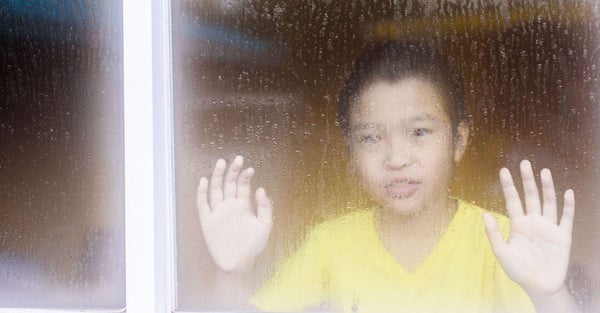Although more and more people are starting to learn about radon, many people still haven't heard of it.
Have you heard of radon?
If you have, it was likely during the sale or purchase of a home.
If you haven't, you'll be surprised to find out that the health effects of radon can be devastating.
So, what is radon, and how does it affect your health?
We'll take a look at that question and more in the article below.
Concerned about one day suffering from radon poisoning? Read our earlier blog post, "A Simple Guide to Radon Testing | How Does it Work and What You Should Know"
Table of Contents
- What Is Radon?
- How Are You Exposed To Radon?
- Health Effects of Radon
- What Are the Symptoms of Radon Exposure?
- Preventing Radon Poisoning
- Radon Eliminator
What Is Radon?
Radon is an invisible, tasteless, and odorless radioactive gas.
Radon starts as uranium, which is a heavy metal found in the ground and most rocks.
When uranium decays, it turns into radium. The radioactive decay of radium creates radon.
Radon gas can escape the soil and become part of the air and water.
The outdoor radon level is usually small enough it isn't harmful.
The problems begin when radon gets trapped inside your home, and your indoor radon level builds up high enough to cause health problems.
Even though radon is a naturally occurring gas from the Earth, it is toxic a person breathes in large quantities of these radioactive particles over a long period.

How Are You Exposed To Radon?
Radon exposure occurs when one breathes in large amounts of the gas over an extended period.Large quantities of radon can occur in the home, workplace, school, or other enclosed buildings.
Many of us spend most of our time in our homes. As a result, exposures likely occur there.
Radon can enter your house through cracks in your foundation, cracks in floors, or cracks in your walls.
Once the toxic gas has entered your home, it gets trapped and builds to unsafe levels.
Radon exposure can happen in any home, whether built on a slab, has a crawlspace, or basement.
Unsafe radon levels are more likely to occur in homes that are well insulated, tightly sealed, and located where the soil contains a lot of radium, uranium, and thorium.
Radon specialists measure the gas in picocuries per liter (pCi/L), and anything over four pCi/L is considered unsafe.
Estimations say about 1 in every 15 homes has high radon levels, so there's a decent chance your home has elevated levels.
The highest concentration of radon is typically found in the basement or the lowest floor of the home.
Health Effects of Radon
Radon is a significant cause of lung cancer, causing about 21,000 lung cancer-related deaths each year.
In fact, it is the second leading cause of lung cancer, right behind smoking.
An increased risk of lung cancer was first discovered in uranium miners exposed to very high radon concentrations.
Studies in Europe, North America, and China also confirmed that even low radon concentrations, such as the levels commonly found in residential settings, pose significant health risks.
Your risk of lung cancer increases by about 16% per 100 Bq/m3 increase in a long time average radon concentration.
The risk of cancer from radon exposure rises proportionally with increasing radon exposure.
Your risk of cancer from radon depends on outside factors as well.
For example, radon is much more likely to cause lung cancer in smokers.
Smokers are about 25 times more at risk from radon poisoning than non-smokers.
There aren't any other cancer risks or other health effects established yet.
Inhaled radon can deliver radiation to other organs but at a much lower level than to the lungs.
What Are the Symptoms of Radon Exposure?
Symptoms from radon poisoning don't present themselves right away.
Health issues from radon exposure instead show up after many years.
Lung cancer may start as a nagging cough, shortness of breath, or wheezing that won't go away.
Other symptoms of radon poisoning or lung cancer are coughing up blood, chest pain, or weight loss.
If you notice any of these symptoms, you should call your doctor right away.
Unfortunately, there aren't any routine tests that will tell you if you've been inhaling too much radon.
And there's no way to clear it from your body.
Most people don't realize they've been exposed to radon until it's too late.
That's why if you think you've been exposed to radon or you're experiencing any symptoms, you should speak to your doctor about whether you should have tests to check for lung cancer.

Preventing Radon Poisoning
The only way to know if you're being exposed to unsafe levels of radon is to have your home tested.
Radon test kits are widely available and generally cheap or, in some cases, free, or you can work with a professional radon testing company.
DIY radon kits include a collector that needs to be left in the lowest habited room of the house for 2–7 days for a short-term test.
You will then send them to a laboratory for evaluation.
Experts recommend long-term testing for radon because radon levels can fluctuate from day to day, week to week, and month to month.
A long-term test will give you the most accurate results.
If the radon readings are high, you can start the radon mitigation process.
The most common mitigation methods are:
- Sub-slab depressurization, or soil suction: This method uses a vent pipe and a radon fan that pulls radon from under your house and vents it to the outside.
- Improved ventilation: Make sure your house is well ventilated so air can easily flow in and out. You should also avoid moving radon from lower floors to the rest of the home.
- Radon sump system: A sump is a cavity under your floor where a pipe is inserted. A radon fan pulls air and radon up and away from home.
- Positive pressurization: Positive pressurization systems blow fresh filtered air into the home to clear out radon.
Making your home airtight will not limit radon levels until you implement other measures.
Studies demonstrate the link between radon and cancer, but its implications for health at the levels that occur in the home are still up for debate.
Smoking makes conclusions difficult to reach.
However, all homeowners should test their homes and place adaptive measures if necessary.
Radon Eliminator
The Radon Eliminator team understands the health risks of exposure to dangerous levels of radon.
If you think you have any symptoms of radon poisoning, there is no better time than now to have your home tested.
If your home has an elevated radon level, you and your family could be at risk of developing lung cancer.
Radon Eliminator can test your home, and if radon levels come back high, we can install a radon mitigation system to lower the radon levels in your home.
Click below to take action and get started with Radon Eliminator.





